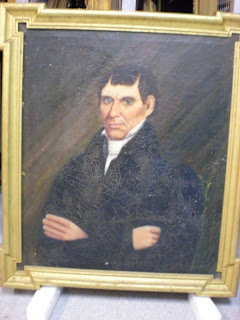But there are problems that might not be obvious to the novice. Is 1793 a birthdate? If so, Miss Pierce was painted at the age of seven, which she clearly is not in this picture ("Pinxt" is a Latinized way of saying "painted"). It should also bother you that "Cintha" is so clumsily spelled.
Fortunately we have the mate to this portrait, Cynthia's husband Silas. On the reverse of his portrait ithere is another inscription, but before reading it you should note the look of the canvas. It is much more patinated than hers. This is what an original canvas back looks like. The inscription looks period too, with the appropriate flourishes of the brush. Here is what his reads: "Silas Pierce/born June 26rh 1772/Painted June 1830/by/Noah Alden." So the 1772 and 1793 dates are their birthdates, and the paintings were done in 1830, not 1800.
This is what probably happened. Mrs. Pierce (not "Miss" as the inscription says) was relined at some point. In this process, a restorer will trim the egdes of the canvas and use non-acidic adhesives and heat to attach the old canvas to a new one. This is often done to stabilize a painting that is torn or flaking. In the process, however, you lose the original reverse. In this case, I think the restorer or owner tried to replicate the original inscription on the new canvas. And made several mistakes in the process.
There's one more little tidbit on the back of Silas' portrait that is worth noting. Way down in the lower right hand corner, the artist has included the price: $13.00. That's a detail worth preserving.






No comments:
Post a Comment